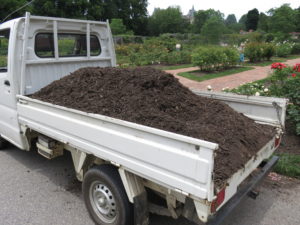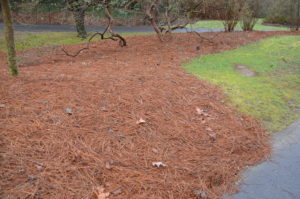Mulching benefits garden soil and enhances the landscape appearance.
Here is how:
- Prevents weed seeds from germinating, thereby reducing hand weeding.
- Mulching keeps plant roots moist and cool in summer.
- Fall mulching acts like a thermal blanket and aids newly set plants to establish their roots quickly.
- Reduces the need to water the garden as often.
- Conservation measure via soil runoff protection.
- Reduces soil compaction which permits rainfall and irrigation water to penetrate the soil surface.
- Encourages beneficial insects and microorganisms.
- Mulch decomposes and improves the organic level of the soil.
- Offers a tidy appearance to the garden.
- Certain kinds of mulch increase or decrease soil pH over time. Decomposition of oak leaves, holly leaves, and pine needles will lower pH over time. Mulch derived from hardwood bark tends to raise soil pH slightly over time.
Acid-loving plants such as blueberries, rhododendrons, azaleas, mountain laurels (Kalmia), and many evergreen shrubs benefit from low pH soils. To raise soil pH, apply hydrated lime (contains calcium) or dolomitic limestone (contains magnesium). Mulches derived from fresh sawdust or wood chips may tie up available soil nitrogen and plant foliage turns yellow (chlorotic). Do not over apply uncomposted mulches around landscape plants.
Typically, spring mulching entails adding 3-4 inches of composted mulch which may be purchased from garden centers or big box stores. Your city may sell or giveaway partially decomposed yard waste, a mix of cut tree/shrub prunings plus lawn clippings and leaves which have been ground up and composed for 3-6 months.
When not to mulch: do not mulch fall-planted fruit trees and shrubs the first year. Vole and other critters make their winter homes in the mulch and gnaw on the sweet soft bark of these plants. After the winter is over, fruiting plants may be permanently mulched.



 Posted in
Posted in 
